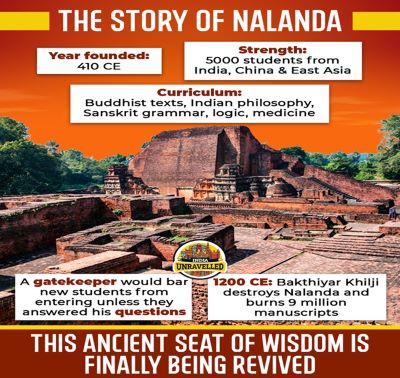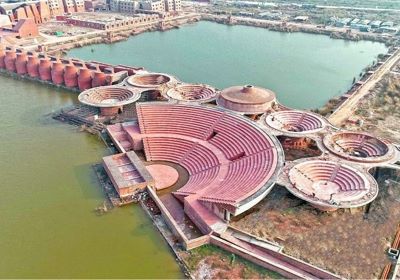Context-
Nalanda, an ancient seat of learning, has captured the imagination of historians and scholars for centuries. The recent inauguration of the new Nalanda University campus at Rajgir by Prime Minister Narendra Modi has rekindled interest in its storied past and ambitious future. As the Prime Minister remarked, “Nalanda is not just a name, it is an identity... knowledge cannot be destroyed even though books burn in a fire.”
The Establishment and Rise of Nalanda
● Foundation by the Gupta Dynasty
Nalanda was established around 5th Century AD by Emperor Kumaragupta-I of the Gupta dynasty. It quickly became a renowned center for learning, attracting scholars from far and wide. With the support of the Pala kings and the monks of Nalanda, who were patronized by the Pithipatis of Bodh Gaya, Nalanda flourished as a sacred site for the spiritually inclined and a hub of intellectual activity.

● A Beacon of Buddhist Scholarship
Nalanda’s faculty included some of the most revered names in Hinayana and Mahayana Buddhism. The latter sect, which began much later than Hinayana, flourished and spread its influence across Tibet, China, Japan, and much of Southeast Asia. Among the luminaries associated with Nalanda were Aryabhata, Harsha, Dharmapala, Nagarjuna, Dharmakirti, Asanga, Vasubandhu, Chandrakirti, and Silabhadra. The Chinese pilgrim Hiuen Tsang, who spent five years at Nalanda during the reign of Harshavardhan in the 7th century, documented its meticulous approach to enrolling students, including rigorous admission tests.
● Global Recognition
The glory of Nalanda was acknowledged in numerous historical texts. In the "History of Bangladesh: Early Bengal in Regional Perspectives," editors Abdul Momin Chowdhury and Ranabir Chakravarti, with a foreword by Romila Thapar, highlighted its celebrated status as a Buddhist site. They noted that Nalanda gained prominence after Alexander Cunningham identified it with Bargon, based on Hiuen Tsang's travel notes and epigraphic records. Thapar herself wrote in "A History of India" about Nalanda’s global repute, mentioning a king of Sumatra who requested permission from a Pala king to endow a monastery at Nalanda, underscoring the strong ties between Buddhists in eastern India and Southeast Asia.
The Fall of Nalanda
● Early Attacks
Nalanda University, a symbol of ancient Indian scholarship, faced two notable attacks. The first occurred between 455 and 470 AD when the Hunas, a Central Asian tribal group, invaded during Emperor Samudragupta's reign, primarily seeking to plunder. The damage was minimal, and Emperor Skanda Gupta later re-established the university, founding its renowned library.
The second attack happened in the early 7th century, driven by political tensions between Goudas Rajvansh, the emperor of Bengal, and Emperor Harshavardhana of Kannauj. Despite some destruction, Harshavardhana restored Nalanda, allowing it to continue its mission of global knowledge dissemination. These incidents highlight Nalanda’s resilience and enduring legacy as a center of learning.
● Khalji Raids
Nalanda’s illustrious history was marred by its destruction around 1200 AD. Historians have recorded that Bakhtiyar Khalji ransacked Nalanda, reducing its treasure of books to ashes. Satish Chandra, in "History of Medieval India," noted that Bakhtiyar Khalji, appointed in charge of areas beyond Banaras, took advantage of his position to raid Bihar frequently. During these raids, he attacked and destroyed famous Buddhist monasteries, including Nalanda and Vikramshila, which were left unprotected.
● Conflicting Historical Accounts
While some historians like Satish Chandra and Minhaj-i-Siraj in "Tabaqat-i-Nasiri" documented the destruction of Nalanda by Bakhtiyar Khalji, others have contested this claim. Noted historian Mohammad Habib, in "Studies in Medieval Indian Polity and Culture," referred to Bakhtiyar’s raids in Bihar but did not directly mention the destruction of Nalanda. Habib wrote about Bakhtiyar’s conquests in Bihar and Bengal, highlighting the fall of Indian kingdoms to the Ghurid army.
● Alternative Theories
D.N. Jha, in his book "Against the Grain: Notes on Identity, Intolerance and History," argued against the widely accepted narrative. Jha claimed that the fortified monastery captured by Bakhtiyar was known as Audand-Bihar or Odandapura-vihara, not Nalanda. He suggested that Minhaj-i-Siraj referred to the ransacking of the fort of Bihar or Hisar-i-Bihar, not Nalanda. According to Jha, Nalanda escaped the main fury of the Muslim conquest because it lay off the main route from Delhi to Bengal, requiring a separate expedition.
Namit Arora, in "Indians: A Brief History of Civilization," supported this view, reasoning that by the time of the Turko-Persian invasions, most Buddhist sites had already been abandoned, destroyed, or converted into Brahminical sites across much of India. He argued that Buddhist artifacts and texts were wiped out, and Buddhism vanished from India’s public memory, only to be rediscovered in the 19th century.
Rediscovering Nalanda
● 19th Century Rediscovery
The 19th century marked the rediscovery of Nalanda, bringing its historical significance back into the limelight. Archaeological excavations revealed the grandeur of the ancient university, rekindling interest in its legacy. Scholars and historians worked to piece together its history, relying on accounts like those of Hiuen Tsang and other ancient texts.
● Modern Efforts to Restore Nalanda
The recent inauguration of the new Nalanda University campus at Rajgir is part of a broader effort to restore Nalanda's past glory. The modern campus aims to revive the spirit of intellectual pursuit and academic excellence that defined ancient Nalanda. Scholars hope that this new institution will not only honor the legacy of its predecessor but also contribute to contemporary academic and cultural exchanges.
● The Vision for Nalanda University
The vision for the new Nalanda University is ambitious. It seeks to become a global center for learning, fostering a multidisciplinary approach to education that reflects the diversity and richness of ancient Nalanda. The university aims to attract scholars and students from around the world, promoting a culture of intellectual curiosity and rigorous scholarship.
Conclusion
Nalanda’s history is a testament to the enduring power of knowledge and the resilience of intellectual pursuits. Its rise and fall, documented by scholars and historians, offer valuable lessons for contemporary academia. As the new Nalanda University campus opens its doors, it carries forward a legacy of learning that transcends time and geographical boundaries. For the discerning, Nalanda remains an open book, inviting interpretation and exploration, much like Oscar Wilde's assertion that “The word is nothing; interpretation is everything.”
|
Probable Questions for UPSC Mains Exam- 1. How do modern efforts to restore Nalanda University aim to emulate and build upon the legacy of the ancient center of learning, and what challenges might they face in achieving this goal? (10 Marks, 150 words) 2. In what ways do differing historical accounts and interpretations of Nalanda’s destruction reflect broader debates about the preservation and understanding of historical narratives in India? (15 marks, 250 Words) |
Source- The Hindu







